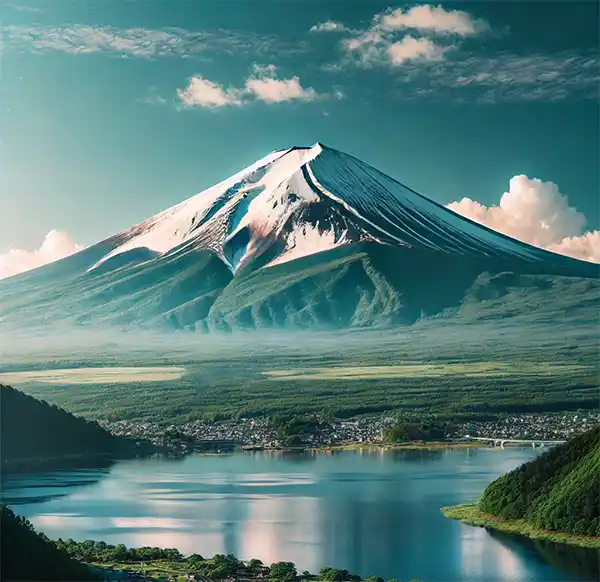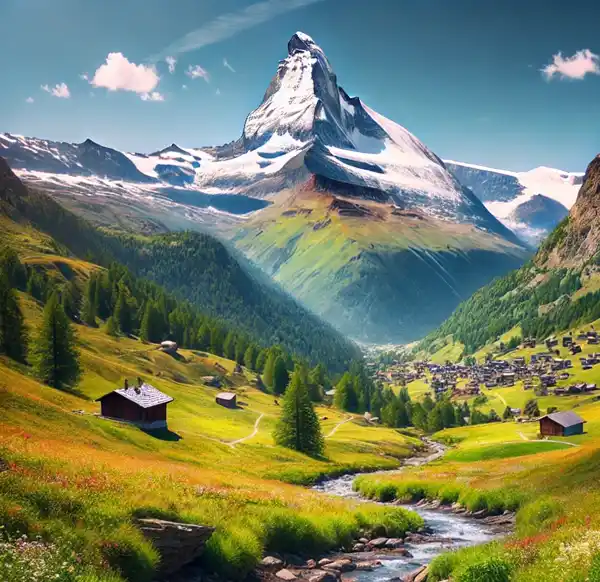A Peak Celebration of Earth's Majestic Giants
Mountains, those towering behemoths of rock and earth that make you feel small yet oddly triumphant when you finally manage to scale one. Whether you’re an experienced mountaineer or someone who just enjoys the view from the safety of your living room window, there’s something undeniably awe-inspiring about these natural wonders. On Mountain Day, we take a moment (or perhaps a whole day, if you're feeling adventurous) to appreciate these colossal formations that have stood the test of time, weather, and a few million tourists.
Mountain Day, known as "Yama no Hi" (山の日) in Japanese, is one of the most recent additions to Japan's calendar of public holidays. Celebrated annually on August 11th, this day was officially established in 2016 with the goal of giving people an opportunity to appreciate the country's mountainous landscapes. With over 70% of Japan's terrain covered by mountains, it’s no surprise that the Japanese would dedicate an entire day to these majestic features of their natural environment.
 The choice of August 11th is symbolic: the kanji character for eight (八) resembles a mountain, and eleven (十一) can be seen as two trees standing side by side. Moreover, August was one of the few months in Japan that didn’t already have a national holiday, making it a perfect candidate for this new celebration.
The choice of August 11th is symbolic: the kanji character for eight (八) resembles a mountain, and eleven (十一) can be seen as two trees standing side by side. Moreover, August was one of the few months in Japan that didn’t already have a national holiday, making it a perfect candidate for this new celebration.
Mountain Day was created not just to encourage people to enjoy the mountains but also as part of a broader effort by the Japanese government to address the country's challenging work-life balance. The holiday provides a much-needed break and encourages people to reconnect with nature. Many Japanese take this opportunity to go hiking, visit mountain resorts, or simply enjoy the scenic views that Japan’s mountains offer.
The holiday also holds cultural significance, as mountains have long been revered in Japan, particularly in Shintoism, where they are considered sacred. On Mountain Day, it’s common for people to visit mountain shrines or participate in festivals and events that highlight the cultural and spiritual importance of these natural giants. Whether you’re scaling a peak or simply gazing at it from afar, Mountain Day is a celebration of nature's grandeur and its deep connection to Japanese identity.
A Tale as Old as Earth
Mountains didn’t just pop up out of nowhere; they have a dramatic and rather slow origin story. Picture this: the Earth’s crust is made up of massive slabs called tectonic plates. These plates are like old friends who sometimes get a bit too close for comfort. When they collide or grind past each other, the earth crumples up in places, like the way your socks bunch up in your shoes. Over millions of years, these crumples grow into what we call mountains.
Some mountains, like the Himalayas, are still growing today because those tectonic plates just can’t stop pushing against each other. On the other hand, some older mountain ranges, like the Appalachians, have mellowed out over time, eroded into gentler, more approachable versions of their former spiky selves. In mountain years, they’re the wise old grandpas of the landscape, sitting back and watching the young bucks like Everest show off.
Types of Mountains
Not all mountains are created equal. Just like people, mountains come in all shapes, sizes, and personalities. Some are solitary figures, standing alone and dominating the horizon, while others prefer the company of a range, stretching across continents like a chain of rocky beads.
- Fold Mountains: The most common type, these are formed when two tectonic plates collide and the land is pushed upward. The Himalayas and the Rockies are prime examples of fold mountains. Imagine two wrestlers locked in a never-ending match, pushing and shoving until one gets lifted up—voilà, you’ve got a fold mountain.
- Fault-Block Mountains: When tectonic plates pull apart instead of push together, you get fault-block mountains. Think of it as a giant piece of Earth getting a lift from below while the land on either side drops. The Sierra Nevada in the U.S. is a classic example, like nature’s own version of extreme landscaping.
- Volcanic Mountains: These fiery peaks are born from volcanic activity, when magma pushes its way to the surface and cools into rock. Mount Fuji in Japan and Mount Kilimanjaro in Tanzania are iconic volcanic mountains. They’re the drama queens of the mountain world—explosive and attention-grabbing.
- Dome Mountains: Formed when magma pushes up the Earth's crust but doesn’t erupt, dome mountains are like volcanic mountains that decided to take a chill pill. Instead of blowing their top, they form a rounded dome. The Black Hills in South Dakota are a famous example.

Famous Mountains
Mount Everest often steals the spotlight, but it’s not the only mountain worth mentioning. Here’s a quick tour of some of the world’s most notable peaks:
- Mount Everest: Standing tall at 29,032 feet (8,849 meters), Everest is the king of the mountains. Located in the Himalayas on the border between Nepal and Tibet, it’s the ultimate challenge for climbers worldwide. But don’t be fooled by its fame—Everest is a brutal, unforgiving host, where one misstep could leave you with a permanent winter vacation.
- Mount Kilimanjaro: Africa’s tallest mountain at 19,341 feet (5,895 meters), Kilimanjaro is a lone giant in Tanzania. What makes it special? It’s a free-standing volcanic mountain, meaning it’s not part of a mountain range. Plus, you can experience five different climate zones as you hike to the top. It’s like traveling from the tropics to the Arctic in just a few days.
- Mount Fuji: Japan’s iconic snow-capped peak, Mount Fuji, stands at 12,388 feet (3,776 meters). It’s a symbol of beauty, culture, and, for some reason, an endless supply of postcards. The symmetrical cone of this dormant volcano makes it a magnet for both tourists and artists alike.
- The Matterhorn: The Matterhorn in the Swiss Alps is one of the most recognizable mountains in the world, with its sharp, pyramid shape. Standing at 14,692 feet (4,478 meters), it’s the perfect blend of danger and allure, like a James Bond villain’s lair.
- Denali: Formerly known as Mount McKinley, Denali is the tallest peak in North America, towering at 20,310 feet (6,190 meters). Located in Alaska, it’s as remote and wild as they come. If you’re looking for a mountain that tests not just your physical limits but your mental ones too, Denali is ready and waiting.
 Scaling New Heights of Celebration
Scaling New Heights of Celebration
Mountain Day is the perfect excuse to embrace your inner adventurer. Whether that means hiking up a local hill, taking a scenic drive through a mountain range, or simply watching a documentary from the comfort of your couch, it’s all about appreciating these natural wonders.
For the more daring, why not try your hand at rock climbing? It’s like mountain hiking but with a vertical twist and a side of adrenaline. Just remember, gravity is always watching, so make sure you’re properly equipped and trained before you start scaling any cliffs.
If climbing isn’t your thing, how about a peaceful picnic with a mountain view? There’s something truly calming about sitting in the shadow of a towering peak, munching on sandwiches, and thinking about how small your daily worries seem in comparison.
And let’s not forget the art of simply enjoying the view. Mountains have a way of putting life into perspective. Their sheer size and age remind us that the world is vast and we’re just tiny specs in the grand scheme of things. So, on Mountain Day, take a moment to breathe in the fresh mountain air, whether you’re at the summit or just imagining it from your backyard.
The Importance of Mountains
Mountains aren’t just pretty to look at; they play a crucial role in our planet’s ecosystem. They’re often referred to as “water towers” because they provide fresh water to more than half of the world’s population. The snow that caps many mountains melts and flows into rivers, supplying water to cities and farms below.
Mountains also support a rich diversity of plants and animals, many of which can’t be found anywhere else on Earth. The unique climates created by varying altitudes allow for a range of ecosystems, from lush forests at the base to barren tundras at the peaks.
But these majestic giants are also vulnerable. Climate change is causing glaciers to melt, threatening water supplies, and endangering the species that call mountains home. Deforestation, mining, and tourism can also take a toll on these fragile environments. So, while we celebrate Mountain Day, it’s also a reminder to protect and preserve these incredible landscapes for future generations.
A Metaphor Worth Exploring
It wouldn’t be a proper Mountain Day celebration without a little philosophical reflection. After all, mountains have long been used as metaphors for life’s challenges. We’ve all heard the saying, “It’s not the mountain we conquer, but ourselves.” And while that might sound like something you’d find in a motivational poster, there’s truth to it.
Climbing a mountain, like any difficult task, requires perseverance, determination, and sometimes a bit of blind faith. The journey might be tough, with unexpected obstacles and moments where you want to turn back. But reaching the summit, even if it’s just a metaphorical one, brings a sense of accomplishment that makes it all worthwhile.
So, on Mountain Day, take a moment to think about the mountains in your own life—whether they’re actual peaks you want to climb or personal goals you’re striving to achieve. And remember the view from the top, real or imagined, is always worth the effort.
Mountain Day is more than just an excuse to marvel at some pretty rocks; it’s a celebration of nature’s resilience, beauty, and power. Whether you’re an avid climber or someone who prefers to admire mountains from afar, this day is a chance to connect with these awe-inspiring formations in whatever way speaks to you.
So, lace up your hiking boots, pack a snack, and head to your nearest mountain—or, if that’s not an option, find a cozy spot with a view. And as you gaze up at those towering peaks, take a moment to appreciate not just the mountains themselves, but the journey they represent. After all, life’s a climb, but the view is great—especially on Mountain Day.
Please Share our Content






 The choice of August 11th is symbolic: the kanji character for eight (八) resembles a mountain, and eleven (十一) can be seen as two trees standing side by side. Moreover, August was one of the few months in Japan that didn’t already have a national holiday, making it a perfect candidate for this new celebration.
The choice of August 11th is symbolic: the kanji character for eight (八) resembles a mountain, and eleven (十一) can be seen as two trees standing side by side. Moreover, August was one of the few months in Japan that didn’t already have a national holiday, making it a perfect candidate for this new celebration.
 Scaling New Heights of Celebration
Scaling New Heights of Celebration








 "Sláinte!" is a traditional Irish expression used as a toast, equivalent to "Cheers!" in English.
"Sláinte!" is a traditional Irish expression used as a toast, equivalent to "Cheers!" in English.